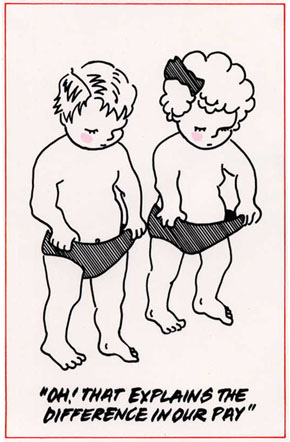CEVEP... coalition for equal value, equal pay |
|||||
| Gendered
jobs |
|||||
Gendered jobs, and gender
neutral job evaluations
 |
In most societies and economies, women and men often do different kinds of work. This is true of traditional societies, and even new fields of work - computing, for example, or science - tend to divide into specialities more likely to employ men or women. Jobs that are thought more appropriate for a man or for a women are gendered jobs. In New Zealand, a third of all women work in 10 most common occupations. Almost half work in occupations that are more than 80% female, and these female-dominated occupations tend to be lower paid. A third of Maori women are concentrated in about 10 occuations, and the same is true for Pacific women. Men seem to have a wider choice - only 25% work in the top 10 typically male occupations. At the level of the labour market, this is called occupational segregation - by gender and by ethnicity. There is international evidence that the higher the proportion of women or of an ethnic minority employed in an industry, an occupation, a firm, or even a work team, the lower the average pay. |
Vertical segregation is well known to women as 'the glass ceiling' in career paths. There are fewer women in higher level jobs, and this also affects the gender pay gap in average earnings.
Most of the typical jobs that women hold today reflect women’s traditional unpaid work in the family. Jobs such as food preparation, cleaning, serving or caring for others – children, patients, customers or bosses. This is important, necessary work and there's a lot of it to be done. Health, education, and personal and community services are all growing areas of the economy that rely on large numbers of women employees.
However, caring and human relations skills may be seen as ‘natural’ for women, rather than as skills developed through practice and experience. Levels of responsibility for health, wellbeing or even lives may go unrecognised and be undervalued.
Women in typical 'women's work' jobs may be undervalued and underpaid, compared to pay levels in typical jobs for men requiring similar levels of skill, qualifications, responsibility, effort and conditions of work.
Are women choosing the wrong jobs?
Is Equal Employment Opportunities the answer? Should all New Zealand women become plumbers and airline pilots in order to be paid as well as men?
CEVEP strongly supports EEO and has been actively part of campaigns for legislation and policy on equal employment opportunity in training, hiring and promotion. We raise our daughters in the belief they can do anything, they can choose whatever career they want. Yet there are still few women in traditionally male trades. The glass ceiling in government, universities and business is an ongoing reality despite these efforts.
Because there is nothing wrong with the jobs most women do. Education, health care, welfare and community services, hospitality and personal services - these sectors are all of great importance to a modern democratic society like ours. They are all sectors that rely on the skills and labour of many women, and it is work that women get satisfaction from doing.
One study in the 1990s etimated that, to get an even distribribution of women and men across the labour market, 65% of women would need to change their job. Imagine the social and economic chaos if we tried that as policy! Fortunately, at current rates of progress on EEO, it would take 75 years.
EEO policies alone are not enough. Girls can do anything, but many young people looking for a job will find it in a gendered area of work.
In CEVEP's view, there is absolutely nothing wrong with 'women's work' jobs - except the pay.
Gender neutral job evaluations
So how do we fix the pay problem? We started in 1960 and 1972 by passing legislation that complies with the international conventions. Implement has hit some historic wobbles, but according to the Ministry of Business, Innovation and Employment:
"The Equal Pay Act 1972 requires that men and women doing work requiring the same, or substantially similar, skill, effort, responsibility and working conditions are paid the same. In predominantly female work, women are paid what men would be for work requiring the same or substantially similar skills, responsibility, effort and working conditions." (www.dol.govt.nz, 8.7.13)
Pay rates for work done exlusively or predominantly by women should be set or checked using objective assessments. Job evaluation tools have long been used by major overseas corporations to size jobs and reward them appropriately. Modern job evaluation systems are designed to be gender neutral and remove any element of pay discrimination in the jobs typically done by women.
The Department of Labour (now MBIE) developed its own Pay and Equity Review Process and toolkit and an Equitable Job Evaluation System for use in New Zealand.
See more on gender neutral job evaluations...
